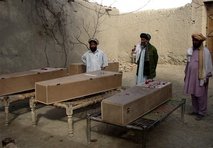Pakistan, Drones, & Blowback
 AP – Pakistani tribesmen stand beside coffins of the victims of a suspected U.S. missile strike in Zharki
AP – Pakistani tribesmen stand beside coffins of the victims of a suspected U.S. missile strike in Zharki
Pakistani reaction to US drone attacks in Pakistan grew this week
with the Pakistani Senate unanimously passing a resolution condemning
the attacks. Last week there were two US drone attacks, the first
during the Obama administration, that killed 20 people.
Yesterday a Reuters report summed it up:
The United States carried out about 30 missile attacks in 2008 and four this year, according to a Reuters tally.
The
attacks have killed about 250 people, including foreign militants,
according to a tally of reports from Pakistani intelligence agents,
district government officials and residents.
Pakistan says the attacks are a violation of its sovereignty and undermine efforts to tackle the militants.
Civilian
casualties in the strikes drive Pashtun tribesmen into the arms of the
militants and undermine efforts to drive a wedge between civilians and
the militants, the military says.
Analysts say the strikes are
also undermining the position of the civilian government and President
Asif Ali Zardari, widower of assassinated former prime minister Benazir
Bhutto, by making them appear powerless to stop what many see as U.S.
aggression.
Many Pakistanis oppose support for the United States and see the U.S.-led campaign against militancy as a war against Muslims.
These
strikes are a classic case of blowback syndrome and in this case in the
key of “tactics trump strategy”. The narrow goal is to rack up a
military “kill” of an insurgent or insurgents. Instead, the attacks
(which often kill the wrong people) end up weakening a key ally, making
it harder for democracy to thrive in Pakistan, driving communities
along the Afghan border into the arms of the Tailban, and creating
recruitment propaganda for al-Qaeda worldwide. That’s a high price to
pay for a errant bomb. And that’s not even including the heartbreak and
pain caused on the flesh and blood human level.
Ironically the
same day Secretary of Defense Robert Gates defended these attacks to
the U.S. Senate Armed Serves Committee, Gates used strong language to
describe the political damage caused by civilian casualties in
Afghanistan. As the AP reports:
Secretary Robert Gates said Tuesday “we are lost” unless the United
States can find a way not to kill so many civilians in the pursuit of
militants in Afghanistan.
Gates also told the committee
that, “civilian casualties are doing us enormous harm”. Like Gen. David
Petraeus, Gates is a student of counterinsurgency strategy (or COIN in
military jargon) which aims to “reduce” civilian casualties to win
hearts and minds and create stability in conflict regions. What these
two smart men apparently haven’t fully grasped is that this insight
about “winning hearts and minds” is even more true of of the current
misnamed “war on terror” which shouldn’t be seen as a counterinsurgency
at all. Keeping the United States (and other nations) safe will not
happen if we look as this as a traditional war of any type. Instead we
need a much more subtle and nuanced approach that pays far greater
attention to the diplomatic and political costs of blunt military
force. When it comes to the safety of my community I’d put far more
stock in building solid bridges with the population and governments of
Pakistan and Afghanistan than in lobbing missiles.


